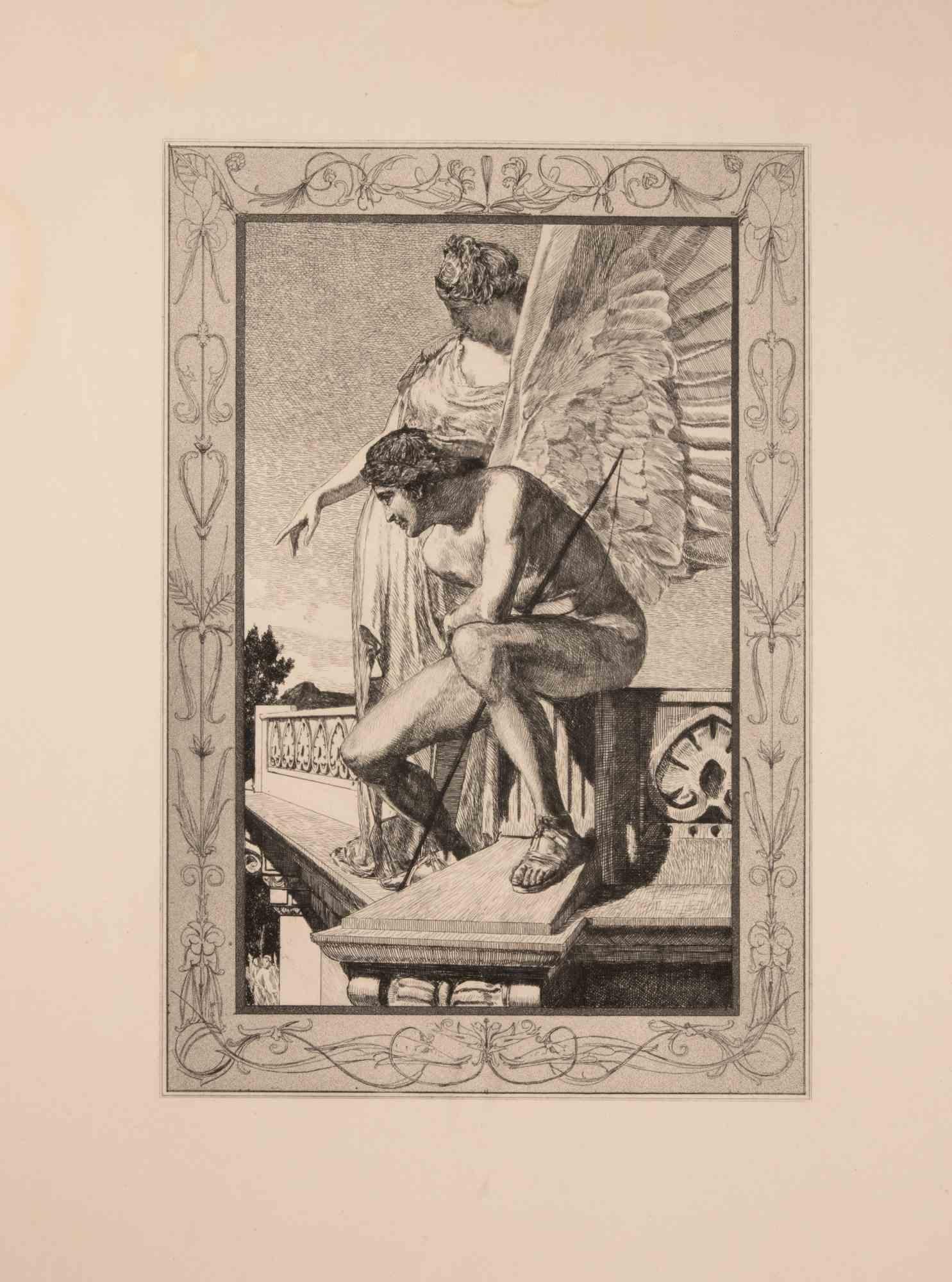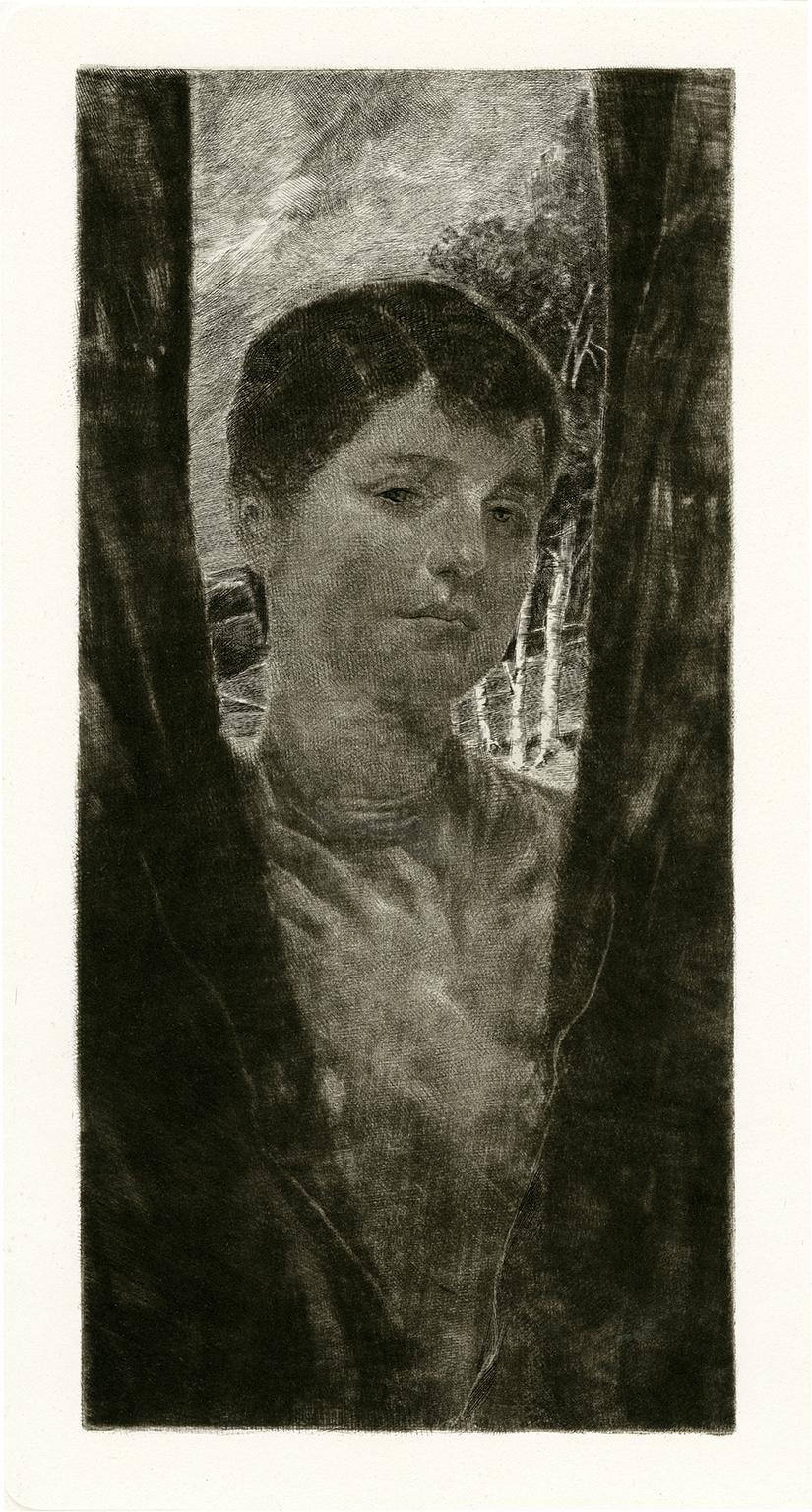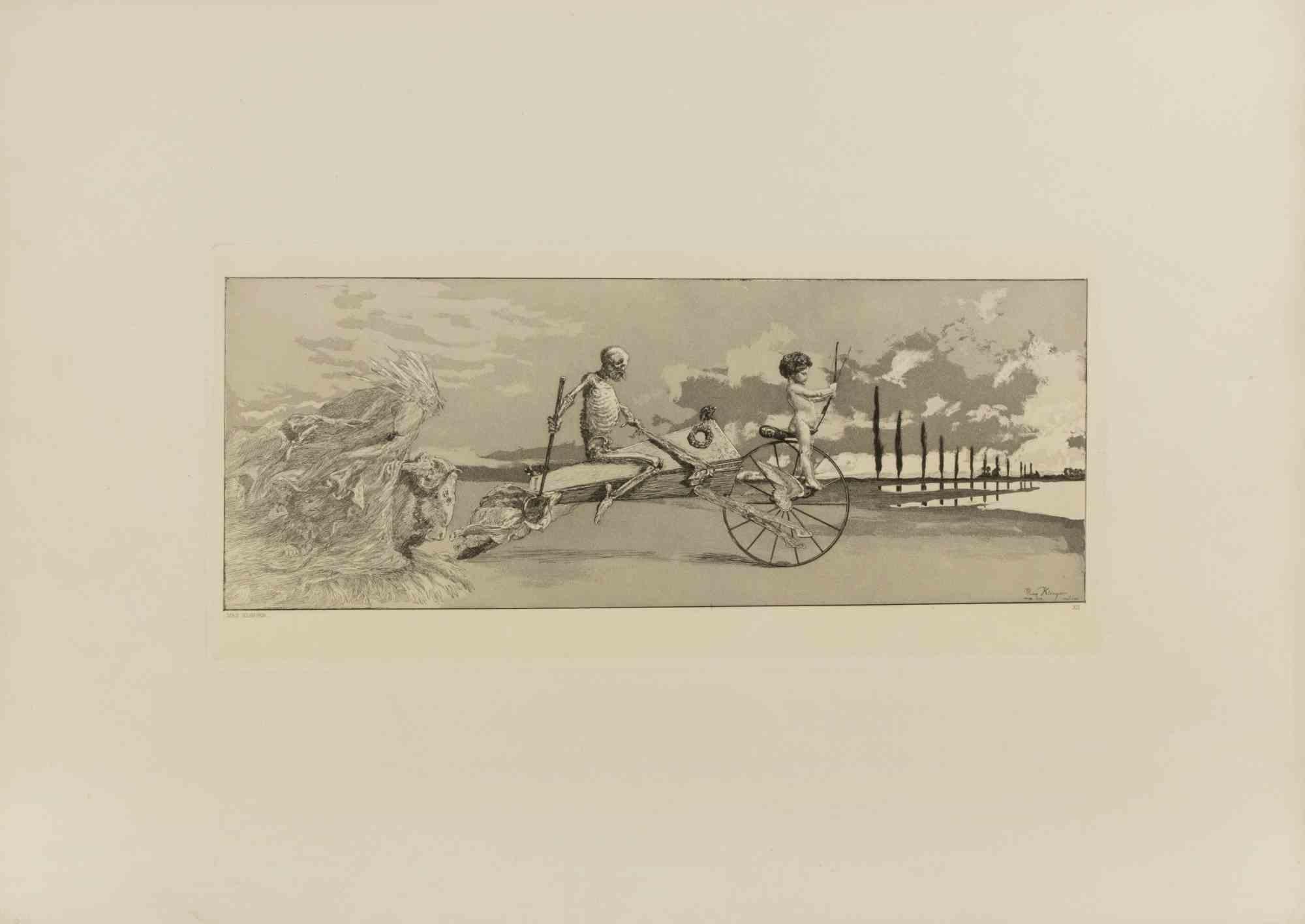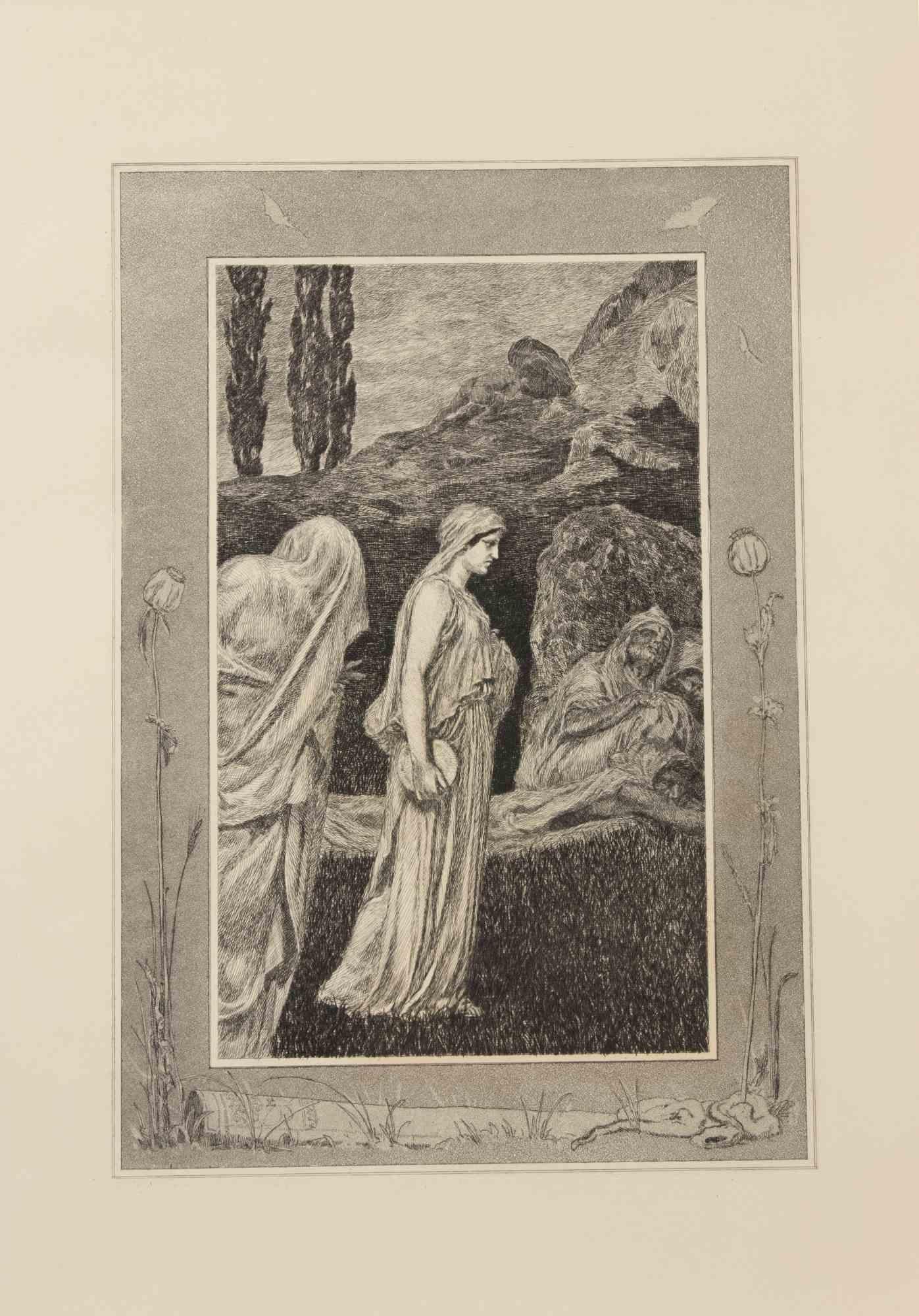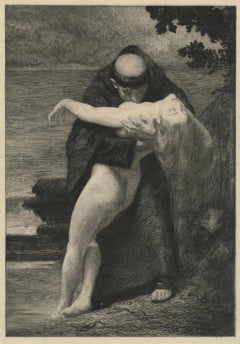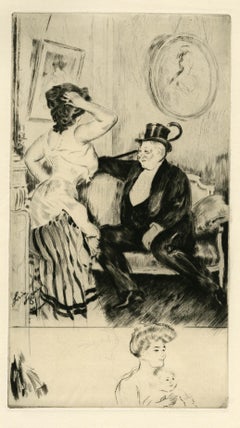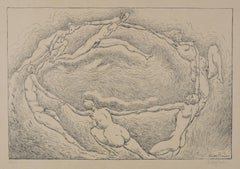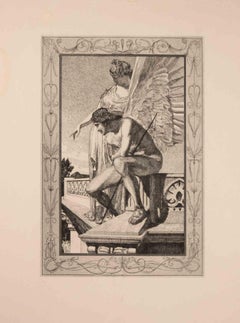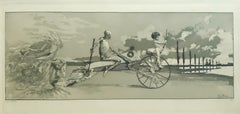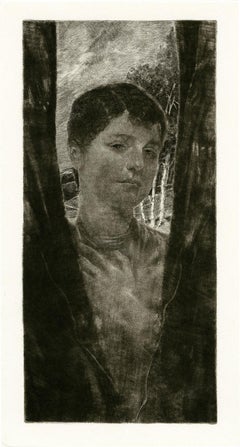Items Similar to Neue Träume von Glück (New Dreams of Happiness)
Want more images or videos?
Request additional images or videos from the seller
1 of 9
Max KlingerNeue Träume von Glück (New Dreams of Happiness)
$1,500
£1,139.29
€1,310.39
CA$2,095.79
A$2,337.05
CHF 1,219.37
MX$28,676.45
NOK 15,520.66
SEK 14,705.49
DKK 9,779.91
Shipping
Retrieving quote...The 1stDibs Promise:
Authenticity Guarantee,
Money-Back Guarantee,
24-Hour Cancellation
About the Item
Neue Träume von Glück (New Dreams of Happiness)
Etching on heavy laid paper without watermark, 1887
Unsigned, as usual
From: Eine Liebe (Opus X) [A Love (Opus X)], Plate No. 7
fourth of four editions, printed in 1903, printed on a yellowish copperplate printing paper
Publisher: Max Klinger
Printer: Wilhelm Felsig
The image Neue Träume von Glück reestablishes the love theme, but in a more meditative mood. While the woman is completely absorbed in her physical union with her partner, the man looks up into a mirror that reflects his visage - a conventional formal device for intellectual self-realization and the transiency of life." Robin Reisenfeld, The German Print Portfolio 1890-1930 (p. 42)
Reference: Singer 163 ?/X
Provenance: Kunst-Salon Maria Kunde, Hamburg
Condition: Large margins
Crumpled upper right corner
Three spots of glue residue verso
small adhesive residue recto
Large margins
Plate: 18 x 14 inches (45.7 x 35.5 cm.)
Sheet size: 26 3/4 x 19 1/4 inches
Impressions of this image are in the collection of the Metropolitan Museum of Art, Museum of Modern Art, Minneapolis Institute of Art, National Museum of Wester Art, Japan
"Among the most prolific and creative printmakers of his era, the German artist Max Klinger (1857–1920) revived printmaking in his native country at a time when it struggled to overcome industrial connotations. During the closing decades of the nineteenth century, he was celebrated for his use of the graphic arts to explore imaginative subjects related to myth and fantasy. Born into an upper-middle-class family in Leipzig, Klinger began to study drawing at a young age. Although he would maintain accomplished practices in various media—including painting, drawing, and sculpture—Klinger’s reputation rested on his experiments in intaglio printmaking. In particular, he often produced these prints as series (“cycles,” as he termed them) that varied from gritty naturalism to esoteric symbolism in content and would influence a generation of printmakers in Germany and beyond over the ensuing century (68.692.1–5; 2002.491a–n).
Klinger began his artistic training as a young man in Karlsruhe under the direction of the social realist painter Karl Gussow (1843–1907). In 1875, he followed his teacher to Berlin to continue his studies at the Royal Academy of Fine Arts. There, he worked alongside Christian Krohg, who encouraged Klinger’s interest—likely inspired by Gussow—in producing socially critical art. The two shared a studio, where they worked side by side and developed their mutual admiration for French naturalist authors such as Émile Zola and Gustave Flaubert, whose novels exposed the darker side of urban life and the hypocrisy of the bourgeoisie. Klinger graduated from the Academy in 1877, and soon after began to produce drawings from life (2007.47) and on nature, many of which related to his growing interest in the evolutionary theory of Charles Darwin.
In Berlin, Klinger also spent time studying prints at the Kupferstichkabinett, a museum dedicated to the graphic arts. Early on, he also studied and absorbed the influence of Japanese art (52.594.22), which at that time was considerably less popular in Germany than in France. He began to experiment with printmaking, producing drawings that he would later reinterpret as etchings (2001.621). The young artist first received acclaim in Berlin for his series titled Paraphrase on the Finding of a Glove (published 1881). Printed in five editions throughout the late nineteenth century, the ten prints follow a vague and fantastic narrative that unfolds after the artist retrieves a glove dropped by a fashionable young woman at a skating rink (2009.46). That night as he sleeps, he dreams an outlandish sequence of events that surround the object’s return to its rightful owner—from its loss at sea (2009.48) to its theft by a monstrous flying bird (2009.53). Throughout the series and despite his young age, Klinger skillfully combined various intaglio media, including etching, drypoint, and aquatint, to striking tonal and formal effect.
After the success of A Glove, the print cycle soon became Klinger’s signature genre. Over the next several years, he explored the social issues that characterized life in modern Berlin. Generally regarded as the first German visual artist to address the social problem of prostitution, Klinger highlighted the hypocrisy of bourgeois morality and the injustices that often befell women in the city. The fifteen etchings of A Life (published 1884) show a young, middle-class subject forced into prostitution after being impregnated and abandoned by her lover and rejected by polite society as a result. Throughout the series, she descends further into the depths of urban culture until she is finally seen nude and exhausted in Caught (63.572.2[1–15]), where, in spite of her pitiable state, she is gawked at and ridiculed by a crowd of genteel onlookers. Her pale skin contrasts sharply with the dark tonality of the jeering group, who themselves disappear into their dank surroundings, suggesting their apathy and callousness through the monochromatic properties of etching.
At the time A Life was published, Klinger was living in Paris, where he relocated for most of the period between 1883 and 1887 after being encouraged by the French art critic Jules Laforgue. Laforgue had seen Klinger’s A Glove during its first Berlin exhibition, in 1878, and promoted his prints to Parisian audiences in the years that followed. Although Klinger’s socially critical work was indebted to his early interest in French literature, the artist soon became disillusioned with the French capital. From his Parisian studio, he began to draft Painting and Drawing, a polemical text that argued for the distinct uses of monochromatic media, such as the graphic arts. Prints, he believed, were better suited to subjects that were imaginative, emotional, and drawn from the darker side of life. Self-published in 1891, the essay asserted a new and significant role for the graphic arts as an original and experimental medium and would inform Klinger’s graphic output for the remainder of his career.
In the years after he left Paris, Klinger explored themes drawn from the contemporary Symbolist movement in even greater depth through his print cycles. He dedicated his 1887 series A Love, for example, to the Swiss artist Arnold Böcklin (1827–1901), whose imaginative work (26.90) he had long admired. While living in Rome (2007.49.377), Klinger produced A Love, which shows a modern Berlin woman (52.586.1[3]) pursued by a suitor who, over the course of the series, seduces, impregnates, and abandons her, leaving her to die in childbirth. The narrative is told primarily via evocative rather than naturalistic means—such as the woman being guided by an allegorical figure of Shame (52.586.1[9]) toward Death, a shadowy, diabolical figure who snatches her infant in the final print (52.586.1[10]). Around this time, Klinger also pursued in greater depth his long-standing interest in music, especially the works of German Romantic composers such as Robert Schumann and Johannes Brahms. The prints of his 1894 series Brahms Fantasies (24.4.62) were meant to accompany the performance of the eponymous composer’s music and create a total, all-encompassing Gesamtkunstwerk through their synthesis of visual art, music, and poetry.
During the 1890s, Klinger began to work less prolifically in printmaking and favor other media. He began work on his last major cycle, On Death II (published 1910), in 1898. For these twelve plates, he drew upon the macabrely creative Totentanz (“dance of death”) theme in German art, which had interested him throughout his career, building upon the iconographic tradition of Renaissance artists such as Hans Holbein the Younger, implying rather than showing death as the ultimate equalizer. In Philosopher (52.586.2[3]), for instance, an allegorical representation of Genius—in the process of contemplating his own existence—is overlaid by a deceased figure rendered in rich shades of aquatint. The paired images allude to the inevitable physical demise that awaits even the intellectually powerful.
By the time Klinger published On Death II, in 1910, he had all but abandoned printmaking. Even then, however, he had already exerted a powerful influence over young graphic artists in Germany, such as Käthe Kollwitz (42.30.16), who saw the print cycle as a powerful new means of narrative expression and formal experimentation. By the early twentieth century, Klinger’s combination of dark themes and the stylistic aspects inherent to print would be taken up by the Surrealists, who praised his exploration of the uncanny, and the German Expressionists, who revived and advanced the graphic cycle as part of their Germanic heritage and Klinger as integral to their national tradition."
Courtest: Britany Salsbury
- Creator:Max Klinger (1857 - 1920)
- Dimensions:Height: 18 in (45.72 cm)Width: 14 in (35.56 cm)
- Medium:
- Movement & Style:
- Period:
- Condition:
- Gallery Location:Fairlawn, OH
- Reference Number:Seller: FA71301stDibs: LU14015276172
About the Seller
5.0
Recognized Seller
These prestigious sellers are industry leaders and represent the highest echelon for item quality and design.
Gold Seller
Premium sellers maintaining a 4.3+ rating and 24-hour response times
Established in 1978
1stDibs seller since 2013
798 sales on 1stDibs
Typical response time: <1 hour
Associations
International Fine Print Dealers Association
- ShippingRetrieving quote...Shipping from: Akron, OH
- Return Policy
Authenticity Guarantee
In the unlikely event there’s an issue with an item’s authenticity, contact us within 1 year for a full refund. DetailsMoney-Back Guarantee
If your item is not as described, is damaged in transit, or does not arrive, contact us within 7 days for a full refund. Details24-Hour Cancellation
You have a 24-hour grace period in which to reconsider your purchase, with no questions asked.Vetted Professional Sellers
Our world-class sellers must adhere to strict standards for service and quality, maintaining the integrity of our listings.Price-Match Guarantee
If you find that a seller listed the same item for a lower price elsewhere, we’ll match it.Trusted Global Delivery
Our best-in-class carrier network provides specialized shipping options worldwide, including custom delivery.More From This Seller
View AllPhrosine and Mélidore
Located in Fairlawn, OH
Phrosine and Mélidore
Etching, 1879
Signed in the polate lower left of image
This etching is after the Dantan painting, a copy after the Pierre-Paul Prud’hom painting
Published by Vv...
Category
1870s Romantic Figurative Prints
Materials
Etching
A L'Ombre (In Shadow)
By Louis Legrand
Located in Fairlawn, OH
A L'Ombre (In Shadow)
Etching & drypoint, 1905
Signed with the red stamp of the publisher Pellet (see photo)
Edition: 50 on velin paper, signed and numbered
Publisher: Gustav Pellet, Paris (his red stamp lower right, recto; Lugt 1193)
Condition: Excellent
Image/Plate size: 5-7/8 x 8-5/8" (14.8 x 21.8 cm.)
Sheet size: 11 5/8 x 17 1/8"
Reference: IFF 119
Exteens 229
Arwas 256 v/V
Louis Auguste Mathieu Legrand (29 September 1863 – 1951) was a French artist, known especially for his aquatint engravings, which were sometimes erotic. He was awarded the Légion d'honneur for his work in 1906.
Life
Legrand was born in the city of Dijon in the east of France. He worked as a bank clerk before deciding to study art part-time at Dijon's Ecole des Beaux-Arts. He won the Devosge prize at the school in 1883.[2] In 1884 Legrand studied engraving under the Belgian printmaker Félicien Rops.
Legrand's artworks include etchings, graphic art and paintings. His paintings featured Parisian social life. Many were of prostitutes, dancers and bar scenes, which featured a sense of eroticism. According to the Hope Gallery, "Louis Legrand is simply one of France's finest early twentieth century masters of etching." His black and white etchings especially provide a sense of decadence; they have been compared to those of Henri de Toulouse-Lautrec, though his drawings of the Moulin Rouge, the can-can dance and the young women of Montmartre preceded Toulouse-Lautrec's paintings of similar scenes. He made over three hundred prints of the night life of Paris. They demonstrate "his remarkable powers of observation and are executed with great skill, delicacy, and an ironic sense of humor that pervades them all."
Two of his satirical artworks caused him to be tried for obscenity. The first, "Prostitution" was a symbolic drawing which depicted a naked girl being grasped by a dark monster which had the face of an old woman and claws on its hands; the second, "Naturalism", showed the French novelist Émile Zola minutely studying the thighs of a woman with a magnifying glass. Defended by his friend the lawyer Eugène Rodrigues-Henriques (1853–1928), he was found not guilty in the lower court, but was convicted in the appeal court and then given a short prison sentence for refusing to pay his fine.
Legrand was made famous by his colour illustrations for Gil Blas magazine's coverage of the can-can, with text by Rodrigues (who wrote under the pseudonym Erastene Ramiro). It was a tremendous success, with the exceptional quantity of 60,000 copies of the magazine being printed and instantly sold out in 1891.
In 1892, at the instigation of the publishing house Dentu, Legrand made a set of etchings of his Gil Blas illustrations. The etchings were published in a book, Le Cours de Danse Fin de Siecle (The End of the Century Dance Classes).
Legrand took a holiday in Brittany, which inspired him to engrave a set of fourteen lithographs of simple country life called Au Cap de la Chevre (On Goat Promontory). It was published by Gustave Pellet who became a close friend of Legrand's. Pellet eventually published a total of 300 etchings by Legrand, who was his first artist; he also published Toulouse-Lautrec and Félicien Rops among others.
He did not only work in graphics; he exhibited paintings at the Paris salon of the Société Nationale des Beaux-Arts starting in 1902. In 1906 he was made a chevalier of the Légion d'honneur.
Legrand died in obscurity in 1951. A retrospective exhibition was held at the Félicien Rops museum in Namur, Belgium in 2006 to celebrate his graphic art. The art collector Victor Arwas published a catalogue raisonné for the occasion.
Books illustrated
de Maupassant, Guy: Cinq Contes Parisiens, 1905.
Poe, Edgar Alan: Quinze Histoires d'Edgar Poe...
Category
Early 1900s Art Nouveau Landscape Prints
Materials
Etching
En passant (Passing by)
By Louis Legrand
Located in Fairlawn, OH
En passant (Passing by)
Drypoint, 1909
Unsigned (as issued in the deluxe portfolio)
From the album "Les Bars" (8 plates plus cover illustration)
Edition: 30, this state with remarque
Published by Gustav Pellet, Paris
A very rich impression wwith burr
Condition: Excellent
Image/Plate size: 9 7/8 x 6 3/8 inches
Reference: Arwas 391a (remarque)
Exteens 277 i/II
IFF 148 (portfolio)
Louis Auguste Mathieu Legrand (29 September 1863 – 1951) was a French artist, known especially for his aquatint engravings, which were sometimes erotic. He was awarded the Légion d'honneur for his work in 1906.
Life
Legrand was born in the city of Dijon in the east of France. He worked as a bank clerk before deciding to study art part-time at Dijon's Ecole des Beaux-Arts. He won the Devosge prize at the school in 1883.[2] In 1884 Legrand studied engraving under the Belgian printmaker Félicien Rops.
Legrand's artworks include etchings, graphic art and paintings. His paintings featured Parisian social life. Many were of prostitutes, dancers and bar scenes, which featured a sense of eroticism. According to the Hope Gallery, "Louis Legrand is simply one of France's finest early twentieth century masters of etching." His black and white etchings especially provide a sense of decadence; they have been compared to those of Henri de Toulouse-Lautrec, though his drawings of the Moulin Rouge, the can-can dance and the young women of Montmartre preceded Toulouse-Lautrec's paintings of similar scenes. He made over three hundred prints of the night life of Paris. They demonstrate "his remarkable powers of observation and are executed with great skill, delicacy, and an ironic sense of humor that pervades them all."
Two of his satirical artworks caused him to be tried for obscenity. The first, "Prostitution" was a symbolic drawing which depicted a naked girl being grasped by a dark monster which had the face of an old woman and claws on its hands; the second, "Naturalism", showed the French novelist Émile Zola minutely studying the thighs of a woman with a magnifying glass. Defended by his friend the lawyer Eugène Rodrigues-Henriques (1853–1928), he was found not guilty in the lower court, but was convicted in the appeal court and then given a short prison sentence for refusing to pay his fine.
Legrand was made famous by his colour illustrations for Gil Blas magazine's coverage of the can-can, with text by Rodrigues (who wrote under the pseudonym Erastene Ramiro). It was a tremendous success, with the exceptional quantity of 60,000 copies of the magazine being printed and instantly sold out in 1891.
In 1892, at the instigation of the publishing house Dentu, Legrand made a set of etchings of his Gil Blas illustrations. The etchings were published in a book, Le Cours de Danse Fin de Siecle (The End of the Century Dance Classes).
Legrand took a holiday in Brittany, which inspired him to engrave a set of fourteen lithographs of simple country life called Au Cap de la Chevre (On Goat Promontory). It was published by Gustave Pellet who became a close friend of Legrand's. Pellet eventually published a total of 300 etchings by Legrand, who was his first artist; he also published Toulouse-Lautrec and Félicien Rops among others.
He did not only work in graphics; he exhibited paintings at the Paris salon of the Société Nationale des Beaux-Arts starting in 1902. In 1906 he was made a chevalier of the Légion d'honneur.
Legrand died in obscurity in 1951. A retrospective exhibition was held at the Félicien Rops museum in Namur, Belgium in 2006 to celebrate his graphic art. The art collector Victor Arwas published a catalogue raisonné for the occasion.
Books illustrated
de Maupassant, Guy: Cinq Contes Parisiens, 1905.
Poe, Edgar Alan: Quinze Histoires d'Edgar Poe...
Category
Early 1900s Art Nouveau Interior Prints
Materials
Drypoint
Circle of Life
By Rudolf Bauer
Located in Fairlawn, OH
Circle of Life
Lithograph on tan paper, c. 1910's
Signed in pencil lower right; signed in the plate lower right
(see photo)
Annotated "No. 50" in pencil lower left (see photo)
...
Category
1910s Expressionist Figurative Prints
Materials
Lithograph
La Toilette
By Louis Legrand
Located in Fairlawn, OH
La Toilette
Drypoint, 1908
Signed and numbered in pencil by the artist (see photos)
Edition: 65 this state (35/65)
Published by Gustave Pellet (1859-1919),...
Category
Early 1900s Art Nouveau Figurative Prints
Materials
Drypoint
Reclining Nude on Bed
By Rudolf Bauer
Located in Fairlawn, OH
Reclining Nude on Bed
Lithograph, c. 1910
Signed in pencil lower right and in the plate, lower right
Image size: 7-1/4 x 13"
Sheet size: 12 1/2 x 19 inches
Condition: very good
Some aging to the tan paper
Provenance: Estate of the Artist
Borghi & Company, New York
Rudolph Bauer
1889-1953
Rudolf Bauer was born in Lindenwald near Bromberg, Silesia, in 1889 but his family moved only a few years later to Berlin. In 1905 Bauer began his studies at the Berlin Academy of Art but left the Academy only a few months later to educate himself. The upshot was paintings, caricatures and comical drawings which were published in 'Berliner Tageblatt', 'Ulk' and 'Le Figaro'.
From 1912 Bauer contributed to the magazine and Gallery 'Der Sturm' founded by Herwarth Walden and pivotal to German Expressionism and the international avant-garde. In 1915 Rudolf Bauer participated for the first time in a group show at Walden's gallery. There he met Hilla von Rebay, with whom he began a relationship of many years that was crucial to Bauer's later work. By 1922 Bauer had shown work at about eight exhibitions mounted by 'Der Sturm'. From 1918 he also taught at the 'Der Sturm' art school, where Georg Muche was the director. After the war ended, Bauer was a founding member of the 'November Group' although he did not collaborate closely with the group. In 1919 Bauer joined forces with the painter and architect Otto Nebel and with Hilla von Rebay to found the artists' association 'Die Krater'. Impressionist at the outset, Bauer's early work reveals Cubist and Expressionist influences. By 1915/16 Bauer had switched to an abstract pictorial idiom, which is markedly influenced by Kandinsky. In the early 1920s Bauer was also preoccupied with Russian Constructivism as well as the Dutch de Stijl group. Bauer's decided preference for non-representational painting culminated in 1929 with the foundation of a private museum, 'Das Geistreich', which he directed as a salon for abstract art.
Political developments in Germany forced Bauer to sell some of his work in America from 1932. His agent in America was Hilla von Rebay, who was by now director of the Guggenheim Collection. In 1936 she organized a touring exhibition of non-representational European art that included sixty Rudolf Bauer oil...
Category
1910s Jugendstil Nude Prints
Materials
Lithograph
You May Also Like
Venus in Muschelwagen - Etching by E. Einschlag after M. Klinger - 1907
By Max Klinger
Located in Roma, IT
Venus in Muschelwagen is a superb black and white etching on paper, realized in 1907 by the German artist Eduard Einschlag (Leipzig 1879 -1945), after Max Klinger (Leipzig 1857 - Gro...
Category
Early 1900s Symbolist Figurative Prints
Materials
Etching
$2,917 Sale Price
30% Off
Venus zeigt Amor Psyche - Etching by Max Klinger - 1880
By Max Klinger
Located in Roma, IT
Etching and aquatint realized in 1880, belonging to the Series "Amor und Psyche", Opus V.
Ref. Singer 67, IV.
Excellent condition.
Category
1880s Symbolist Figurative Prints
Materials
Etching
Amor, Tod und Jenseits - Etching by M. Klinger - 1881
By Max Klinger
Located in Roma, IT
Amor, Tod und Jenseits, (Cupid, death and afterlife) is an original etching and aquatint on paper Chine collé, realized by Max Klinger in 1881, plate XII from “Intermezzi” Opus IV,...
Category
1880s Symbolist Figurative Prints
Materials
Etching, Aquatint
$1,333 Sale Price
30% Off
'Erinnerung (Remembrance)' — Turn-of-the Century Romanticism
By Max Klinger
Located in Myrtle Beach, SC
Max Klinger, 'Erinnerung' (Remembrance), original etching with aquatint, 1896. A fine, richly inked impression on off-white, wove paper, with full margins (1 3/4 to 3 1/8 inches), in...
Category
1890s Post-Impressionist Figurative Prints
Materials
Etching, Aquatint
Love, Death and the Beyond - Etching by Max Klinger - 1881
By Max Klinger
Located in Roma, IT
Love, Death and the Beyond is a original modern artwork realized by Max Klinger in 1881.
The artwork belongs to a series of prints called Intermezzi realized by Max Klinger, publish...
Category
1880s Symbolist Figurative Prints
Materials
Etching
Psyche in Tartarus - Etching by Max Klinger - 1909
By Max Klinger
Located in Roma, IT
Etching and aquatint realized in 1909.
Belongs to the series "Amor und Psyche. Opus V".
Very good condition.
Category
Early 1900s Symbolist Figurative Prints
Materials
Etching
More Ways To Browse
Renaissance Art Pairings
Bird Sculpture Plated
Antique Industrial Mirror
42 Inch Mirror
Antique Japanese Bird Prints
Antique Mirror Sheets
Antique Mirrors With Etching
Unsigned Christian Dior
Antique Macabre
Christian Schumann
Roman Greek Male Nude
Steel Dog Sculpture
W Rochelle
Yayoi Kusama Pumpkin
40x60 Posters
70s Bed Frame
Antique Prints Sydney
Atelier America Inc

